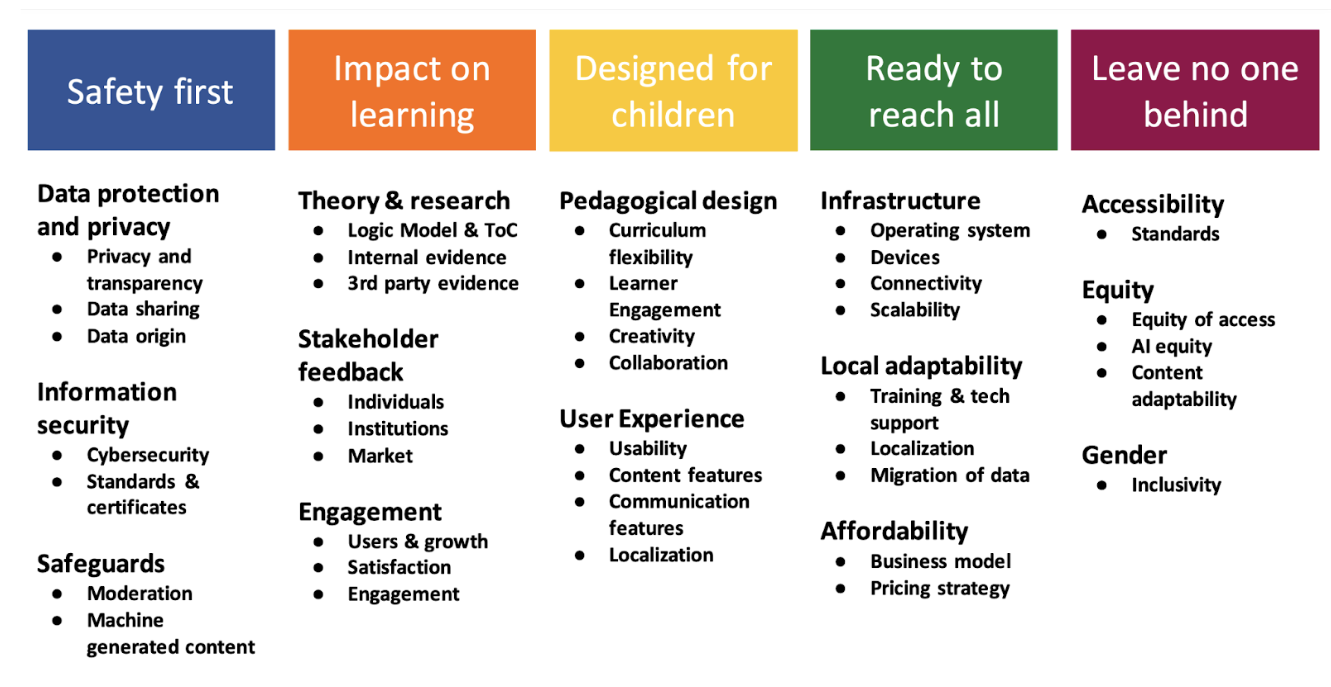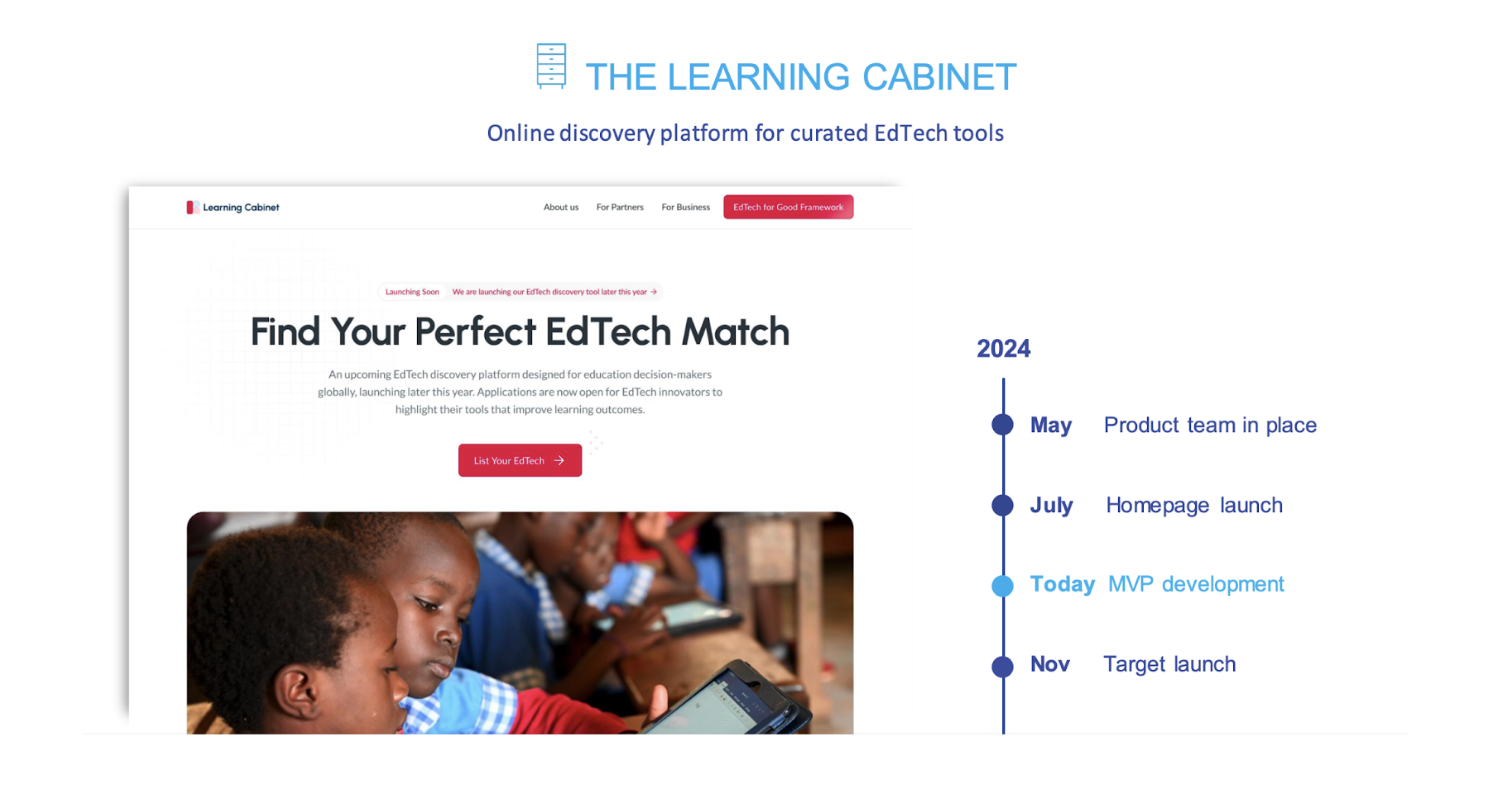Strategy Lab Spotlight: Insights from UNICEF’s Learning Innovation Hub
In our second session for the EdTech Strategy Lab Summer Workshop Series, we had the opportunity to hear from Milja Laakso, Innovation Specialist (EdTech Portfolio) and Jussi Savolainen, Product Lead for the Learning Cabinet Platform, both working with UNICEF’s Global Learning Innovation Hub. Since the session was aimed at exploring the role of Evaluation Developers, Milja and Jussi shared important insights about recent initiatives, including the EdTech for Good Framework and the Learning Cabinet.
To kick off the workshop, Milja Laakso, Innovation Specialist (EdTech Portfolio) at UNICEF, began with a brief introduction to the UNICEF Global Learning Innovation Hub. According to Milja, the core focus of the Learning Innovation Hub is to find new types of solutions to solve the learning crisis–or, as she put it, the learning catastrophe–in low and middle-income countries. Specifically, she cited the increasing trend of the percentage of children who are unable to read and comprehend a basic text by the age of 10. In 2015, this figure stood at 53%, but by 2019, it had risen to 57%, and by 2022, it had further increased to 70%.
Based in Helsinki, the Learning Innovation Hub aims to become the global home for architects of the future of learning and bring together into conversation the more traditional actors in the education space as well as the more unusual suspects: the entrepreneurs, data folks, businesses, even artists and designers.
The goal is to use these collaborations to imagine what the space of education and learning could look like and, in particular, address the enormous challenges the global education landscape currently faces.
To bring this hub to life, they have already partnered with a number of impressive organisations. The Ministry of Foreign Affairs of Finland provides funding, as well as arm. They also have pro-bono and technical partners in the Finnish National Agency for Education, Extreme Tech Challenge, Asian Development Bank, and the Ministry of Education and Culture. Together, these partners have played an important role in the development of the EdTech4Good Framework and the Learning Cabinet, which was the focus of Milja’s short talk during the workshop.
The starting point for UNICEF’s work in addressing the learning crisis sits at the challenging juncture between getting all children to learn and this proliferation of technological innovation that have enormous potential to help solve these problems.
However, the reality is that these technological solutions are not always finding their way to the kids who need it most, and this is particularly the case in the global south where UNICEF works. At the same time, the surge in tech solutions also raises many important questions–especially from governments and partners within the UNICEF network about how they can find, as Milja phrased it, the pathway to the right EdTech. Embedded in their questions are issues with both evidence and trust: How do we identify what the right EdTech solution is? How can we actually trust these solutions?
In an attempt to address these issues, UNICEF is currently working toward two elements that will become public goods:
The creation of the EdTech for Good Framework which will allow robust EdTech curation and assessment
The development of the Learning Cabinet, a platform to discover impactful, scalable, and adaptable EdTech tools.
Although this was not an initiative covered in depth during the workshop, it is worth mentioning that in addition to the two aforementioned initiatives that UNICEF has also established an investment portfolio, called the Blue Unicorn Farm, which will consist of a series of investments into what they identify to be the most scalable education solutions.
The EdTech for Good Framework
This framework builds directly on the work that the Asian Development Bank had already initiated with their Quality, Effectiveness, Scalability, and Affordability (QESA) framework. With the goal of building out an evaluation framework that would be sustainable to manage, use, and update in the long-run, the team at UNICEF convened experts from various disciplines across the education space in Helsinki to develop the initial draft in August of 2023.
Following testing and iteration which began in November 2023, the Beta version has been launched, reflecting the framework’s adaptability to the evolving educational landscape. This adaptability is particularly important, as Milja pointed out, as the education space is evolving, particularly with AI and new technologies, but also in relation to the development of other evaluation tools and frameworks.
The EdTech for Good Framework is open-access and is focused on learning and teaching tools for early childhood development, including K-12, aligning with UNICEF’s target audience. The framework itself consists of over 130 questions from five categories to evaluate EdTech tools. These categories are outlined below:
As shown in the slide Milja shared (below), there is a significant emphasis on safety, impact on learning, and scalability. In addition, principles of inclusion, equity, and accessibility remain at the fore.
Learning Cabinet
In addition to learning about the EdTech for Good Framework, participants also had the opportunity to hear from Jussi Savolainen, Product Lead for the Learning Cabinet Platform during the workshop. The Learning Cabinet is the result of the EdTech for Good Framework and is an online discovery platform of curated EdTech Tools that have been screened.
The target users of this platform are different from other platforms as they are mainly EdTech decision makers in larger scale organisations or governments. They also span a diverse geographical context, which aligns with where UNICEF is operational, and so both the Framework and the Learning Cabinet must take differences in context into account. The aim is to launch the platform by the end of 2024.
Some general challenges with the development of both the EdTech for Good Framework and also the Cabinet lie in the fact that screening these tools is a time consuming process that requires substantial and wide-reaching expertise and rigour. Additionally, how can the platform remain up-to-date and the user experience remain optimised, especially with the updates to the framework. Of course, there is another challenge that arises with the development of additional frameworks, companies are having to go through even larger, more robust evaluation frameworks and, as Jussi aptly put it during the session: there is a need to keep a balance.


